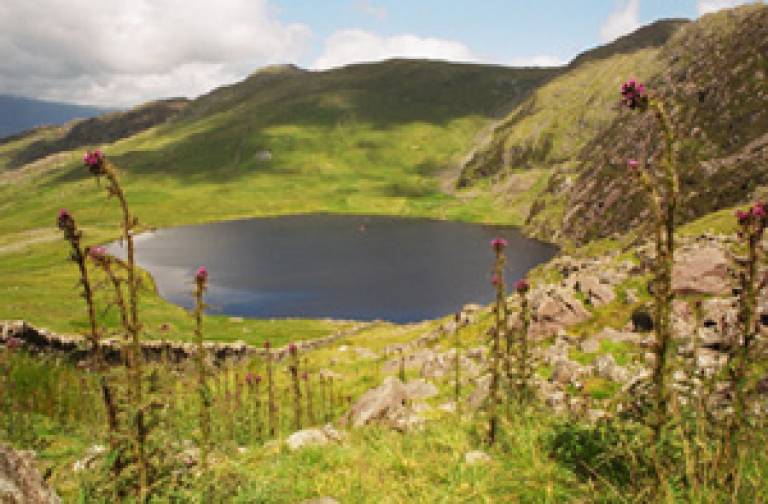Acid rain on the wane
18 November 2005
The UK's upland lakes and streams are beginning to show signs of significant recovery from the effects of acid rain, claims a report published by DEFRA today.
 The new research from the UK Acid Waters Monitoring Network (AWMN) led by a team from UCL, shows that the amount of acidic sulphur in UK waters has generally halved in the last 15 years, resulting in the return of many species of flora and fauna.
The new research from the UK Acid Waters Monitoring Network (AWMN) led by a team from UCL, shows that the amount of acidic sulphur in UK waters has generally halved in the last 15 years, resulting in the return of many species of flora and fauna.
The ongoing project was commissioned by the Department of Environment in 1987 after the government agreed that sulphur emissions were responsible for ecological damage in the Upland regions of the UK. New environmental controls were then introduced and 22 UK lake and stream sites were identified and have been monitored ever since for their chemistry and biology, but it is only since 1995 that the scientists have begun to see a reduction in acidity and the start of an ecological recovery.
"Our results show a massive reduction in sulphur in the water. The concentrations have more or less halved since we first started monitoring. Very little happened in the first few years, but after 1995 levels started dropping rapidly. This change coincided with the introduction of new sulphur scrubbing technology fitted to two major English power stations, and it is likely that the two are linked", explains lead scientist Don Monteith (ECRC).
Up until recently the cumulative effect of over 200 years of industrial pollution had taken its toll on Britain's upland landscape, with soils, streams and lakes becoming increasingly acidic. This in turn affected plants and animals which struggled to cope with the conditions. In some lochs in South West Scotland, stocks of trout had all but disappeared by 1980: "Upland waters tend to support very few species of fish. Those fish that live there are very sensitive to the levels of acidity and the associated high levels of toxic aluminium. If you have free aluminium in the water it can disrupt the functioning of the gills causing great physiological stress," says Mr Monteith.
Encouragingly this process is now being reversed and juvenile brown trout have reappeared, albeit in very small numbers, in three of the most acidic sites studied. Perhaps of more ecological significance has been evidence of widespread return of sensitive algae, higher plants and aquatic invertebrates which underpin the food chain of these ecosystems.
But will things ever return to how they were before the Industrial Revolution? The project's leader, Professor Rick Battarbee (ECRC) is unsure: "At the beginning of the project we examined sediment cores from the lakes, which showed us that biological conditions were quite different in the early nineteenth century than the present day. In theory it should be possible to return to those conditions, but that depends on whether other changes are taking place.
"At some sites we do see a return towards how things were in the past but at other sites that's not the case. In some cases there are new species appearing which weren't present before. So it seems easier to restore the chemical status of the water than the biology."
While the continued recovery of the waters is having a beneficial effect on wildlife, it's causing an interesting side effect: "One of the striking findings of this research is that at every AWMN there has been an increase in dissolved organic carbon (DOC) which makes the colour of the water less transparent. This change is caused by an increase in the supply of humic acids from organic soils. At first we thought this was mainly the result of global warming, but now we now think that at least in part this is related to the recovery process. These lakes were probably somewhat browner in the past but became clearer during the acidification process, so the increasing colour is possibly an indicator of improvement."
While the discoloured water isn't harmful, it can be a problem for the water industry who need to remove the colour to make drinking water acceptable to the public: "Ironically, natural water may be more difficult to treat for human drinking purposes than the polluted water," explains Mr Monteith. However, the water companies' problem could continue as the team envisage that the quality of water in these upland areas will continue to improve over time as emissions are further reduced.
The AWMN research is a joint initiative between UCL's Environmental Change Research Centre, the Centre for Ecology and Hydrology (NERC), the Department of Biological Sciences, Queen Mary University of London and the Fisheries Research Services, Freshwater Laboratory, Pitlochry. The findings were first published in full in September 2005 in a special edition of 'Environmental Pollution' and were summarised in a DEFRA report published on 14 November 2005.
Image: Llyn Llagi monitoring site
 Close
Close

